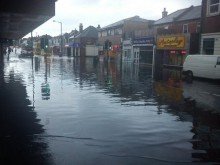The following is correspondence between Simon Bull (Councillor for East Winton) and the Conservative Leader of Bournemouth Council over the stated failure by the council to deal with flooding on Wimborne Road.
Dear Councillor Beesley,
Enough is surely enough. Bournemouth’s sewage system’s repeated inability to cope with excessive rainfall meant that on Thursday night businesses in Winton were flooded once again.The matter needs to be urgently addressed by the Council and an adequate drainage solution put in place.
On Saturday morning I visited the affected area and found despondent shopkeepers who told me that this was a regular occurrence that has been going on, unaddressed, for years. One shop-keeper showed me pictures of goods floating in filthy water, evidence of the large amount of stock he has lost. Another business, that has only been trading in Winton for a matter of months, is considering moving elsewhere because they are already having to replace ruined carpets and furniture for a second time. Shop assistants and owners in each property told me that this time the flood water had gone right through from front to back. This meant a number of them were unable to trade over the weekend, resulting in further loss of revenue on top of the clear up costs. Some were unsure when they would reopen. One asked if the council could provide flood gates in front of the doors to prevent the water getting in.
Recent statistics from the MET office confirm that average rainfall across the UK has increased by 13%. Armed with this evidence, the council should be prepared for more frequent storms like this and while it may have been an unusually high amount of rain it should not have been unexpected. Met office warnings of thunderstorms and flash floods were in place, and water damage could have been prevented.
It is clear that the impact of urbanisation directly affects flooding and in Winton particularly, unlike the centre of town which has natural drainage in the form of the gardens, the tarmac covered high street and the absence of trees or greenery compounds the problems around Wimborne Road caused by these flash floods. The Department of the Environment which enacted the Flood Act of 2010 which promotes sustainable drainage stated that “Climate projections suggest that extreme weather will happen more frequently in the future”. One suggestion for sustainable urban drainage is to replace impermeable surfaces with more permeable ones, allowing rainwater to drain directly into the ground.
While Wessex Water are responsible for the public sewage system they are not responsible for highway drainage and after inspecting the area they concluded that the flooding was not their responsibility. The responsibility therefore lies with the Council and until the Council is able to address the problem it should consider, as a minimum, a rate rebate for those businesses. I would also urge the Council to clearly outline how they plan to increase sustainable urban drainage in Winton and what preventative measures they plan to put in place to reduce future disruption.
Regards
Simon Bull
Councillor
Winton East Ward
Dear Cllr Bull
Thank you for your email.
You have not raised these issues with me previously, nor am I aware whether you have done so within the Council Members’ Flood Advisory Group or the appropriate Overview & Scrutiny Panel. Paul Ambrose is the Council’s Flooding and Drainage Manager and a specialist in his field and so I have been in touch with him since you wrote to me the evening before last to obtain the technical position and the specific details of what actually occurred last Thursday night. Having been given that information, I do not accept that water damage in this case could have been prevented by the Council, nor that there are quick, easy or affordable solutions. However, Council Officers continue to be closely engaged in work in this area.
In addition to those you copied on your email, including the media, I am adding Mr Ambrose and other appropriate Officers of the Council for their information.
Firstly some details of the rain. Last Thursday night, the Town Hall Rain Gauge measured some 50.8mm of rain in three hours. The average rainfall for September is 65.7mm so we had ¾ of a month’s rain in those three hours. However, between 1.00 and 1.10am – i.e. in just 10 minutes – we had 11.6mm of rain or nearly half an inch. That’s one sixth of a month’s rainfall in just 10 minutes. Any drainage system in the world would struggle with that intensity of rain. The problem is that although this does not seem to be a completely isolated occurrence, it is rare and so to quote return periods is not going to be particularly helpful. From time to time we do seem to have short periods of very intense rainfall, usually in the form of thunder storms which result in flash flooding. I recall that this has happened throughout my lifetime but I am not qualified to say whether this is increasing, nor whether it is as a result of climate change.
It is a fact that there is no natural drainage in the form of streams in this area so all drainage is ultimately carried by the piped sewerage system. Various people are responsible for different parts of this network of pipes. Any pipe, in reality only has finite capacity. Nearly all the road gullies and highway drains, which are the responsibility of the Council, ultimately connect into the public sewerage system which is now the responsibility of Wessex Water. All gullies / pipes / sewers have to be designed to a standard and whilst those standards have been raised over the years there is a still a considerable legacy of older infrastructure.
This area of Winton is one of the oldest parts of Bournemouth outside the original Town Centre and is still largely served by a combined sewerage system. Along with the drainage system it has evolved over at least 100 years and the town has experienced considerable growth in that time. This is not unique to Bournemouth and is similar to many other urban areas which have experienced such growth. You just need to see recent press reports of flash flooding across the country to realise this is a common urban problem, but often of course very localised.
The Council has been aware of some flooding in this area in the past, but of course it became obvious after the August 2011 Air Festival flood that there was a significant problem. This was reported to a Flooding Task and Finish Group set up as a result of the event. Out of that came the current Flood Advisory Group and one of their first tasks was to work more closely with all organisations involved in drainage and flooding.
Mouchel were commissioned to look at possible options using a computer model jointly developed by Wessex Water and Bournemouth Council. This computer model alone cost in excess of £100k and took a couple of years to produce. It is a highly technical process to develop these models but really the drainage system must be looked at as a whole, as otherwise often all you do is move a problem rather than solve it.
Various options were evaluated but there simply isn’t a quick and easy answer to prevent flooding. Sustainable Urban Drainage (SuDs) was considered but this would have to be very extensive to make any difference and would probably involve removing so much on street parking as to not be realistic. While the Local Planning Authority does insist that all new developments employ Sustainable Urban Drainage techniques, there is a considerably legacy of older buildings which will not be resolved until they are redeveloped at some time in the future. In reality, there are no nearby public open areas that flood water could be diverted to in order to provide temporary storage. It is not realistic just to make the local pipes bigger because all that does is move the problem downstream. The installation of very large underground tanks could be one possible solution but they would almost certainly have to be under the roadway and most roads are already full of other services. This would require roads to be dug up for months and I am told that the costs would be in the millions of pounds. The only partial solution is known as a ‘super gully’ but it must be stressed this would only ever be a partial solution. The Council has recently been in discussion with Wessex Water over this option. Funding would probably need to be released from the Local Transport Plan.
It may be possible to make the properties more flood resilient / resistant but this is challenging for businesses that have to have good public access to trade. Further, it often requires people to erect flood barriers but for that you need sufficient warnings and this very localised cloudburst occurred at 1.00 in the morning.
One point that is usually raised is the cleaning of gullies which are dealt with on a routine basis. After the warnings we received earlier on the Thursday, the Council sent out the street cleaning teams and updated the clearance of as many of the high risk areas as possible. However, storms of this intensity bring down a great deal of debris and wash dirt / gravel off other privately owned areas which all ends up in the gullies. Afterwards people often claim the gullies have not been cleared but usually it is the actual rain that has moved the debris from elsewhere.
In my experience the Council has never given a reduction in business rates for flooding as any reductions are greatly limited in scope and I suggest that you contact Adam Richens, the Council’s s151 Officer, should you believe that this issue needs to be responded to in more detail.
If your original email has been copied to a wider circulation than those shown above, I should appreciate this response being forwarded to those recipients please.
Regards, John Beesley
Cllr John Beesley FIH
Leader of the Council
Dear Cllr Beesley
Thank you for your response to my email.
Indeed you are correct that the downpour last Thursday was very heavy and over a short time span. However the businesses I spoke to explained that there have been three occasions in less than a year, two of those in the last three months, of flooding in the same location. I am sure we can appreciate how disheartening it must be to have to deal with the results of such flooding and to know that it will happen again. I understand that this has been a problem in the Winton area for over fifteen years and is getting more frequent.
I am aware that Mr Ambrose has previously spoken to the businesses affected. A resident drew my attention to the fact that he highlighted the risk of summer floods at last October’s Environmental Panel where he also brought up the issue of sustainable drainage.In your email you mention that Sustainable Urban Drainage (SuDs) was considered and would have to be very extensive to make any difference potentially involving removing much on street parking. I suspect that in time such action may be necessary. I would be interested in reading an updated policy on sustainable drainage. I believe our residents have a right to know what measures the council is taking to address the problems caused by climate change. Could you confirm whether or not our policy has been updated since the Department Of Environment’s Flood Act 2010?
Regards
Simon Bull
Councillor
Winton East Ward
Dear Councillor Bull
Thank you for your further e-mail of the 23 September 2016 on the subject of Sustainable Urban Drainage (SuDs).
In response to your question “Could you confirm whether or not our policy has been updated since the Department of Environment’s Flood Act 2010?”, the answer is not a simple yes /no as it is felt that the situation is generally adequately covered already.
Hopefully you will be aware that the Floods and Water Management Act of 2010 under schedule 3 proposed a SuDs Approval Body (SAB). This was only fornewdevelopments but this was never implemented. One part of the problem was to agree various technical standards and there was considerable discussion over several years which never reached a conclusion. On 18 December 2014 the then Secretary of State for Communities and Local Government (Eric Pickles) announced in Parliament, that the Town and Country Planning (Development Management Procedure) (England) Order 2010) – was to be amended “to ensure that sustainable drainage systems for the management of run-off are put in place, unless demonstrated to be inappropriate.” This came into force on 6 April 2015. However this only applies to major developments of 10 or more properties.
Bournemouth has been ahead of many Councils in having an adopted Planning Guidance Note (November 2003) (PGN) for many years but again this is only applicable to new developments. This was restated in our Local Plan Core Strategy Policy CS4 ‘Surface Water Flooding’ which was adopted following extensive public consultation and public examination in October 2012. I would point out that this policy is embedded in the ‘Preparing for Climate Change’ Chapter which is intentionally the first chapter of the Local Plan setting the scene for other policies and proposals. Policy CS4 is contained in the section titled ‘Anticipating the Effects of Flooding and Encouraging Sustainable Drainage’ starting on page 16 of the document. The plan be accessed at https://www.bournemouth.gov.uk/planningbuilding/PlanningPolicy/Local-Plan-Documents/TheCoreStrategy.aspx
The policy states:
“The design and layout of all new buildings, and the development of car parking and hard standing, will incorporate appropriate Sustainable Drainage Systems (SUDS) capable of ensuring that the level of surface water leaving the site is no greater than that prior to the development, and ensuring the quality of local water. The use of SUDS is a requirement other than in exceptional circumstances where no technical solution is available. Details of the proposed SUDS and suitable provision for maintenance will be submitted as part of any planning application”.
While our PGN is still sound on principles it could be revisited in the light of more recent technical advances but there is now also a wealth of data on SuDs available (in fact almost too much and way beyond anything we have the technical capability to produce). Probably “the bible” is the new Ciria SuDs Manual (C753) published in November 2015 (available to down load free at https://www.ciria.org/Resources/Free_publications/SuDS_manual_C753.aspx if you are interested).
The reality is that Winton developed long before SuDs were even thought off and we have to deal with the situation as we find it. There is no requirement anywhere to retrofit SuDs. We have in the past considered whether it is feasible to retrofit SuDs to drain the existing highway which contributes a substantial part of the surface water run-off but this has generally not been viable for various reasons. Interestingly there have been a few relatively small scale trial areas in other parts of the Country (Bristol and Swansea are good examples) but these all require space as either off-road sites (which we do not have in this area of Winton) or actually within the highway. However this would require removing considerable areas of on street parking. Parking (or lack of) is a very emotive issue. We also suspect that many private individuals who do have soakaways on their properties to drain their roof water, connect these into the house drains if they have silted up and stopped working. This puts further strain on the sewerage system as well as being in contravention of Building Regulations but I suspect we would be heavily criticised if we started looking for these. Indeed it is doubtful if we have the necessary legal powers anyway.
A while ago the Department of Transport did look at porous asphalt to create permeable road surfaces but this has since been dropped as it was not a big success for roads that took a lot of heavy traffic. While it is technically possible to install it in quieter low traffic roads and car parks it is not just a matter of replacing the surface but significant reconstruction as you require special foundations. So the cost to change to permeable paving is considerably more than just simple resurfacing. It would be good to replace all the roads with permeable surfacing when they are maintained but we simply do not have the finances to do so. However, we have recently adopted a new road (part of Diamond Place) that is a permeable block paving and there are also several other areas that have low traffic loadings being considered.
I have been reminded that there are also further flood / Suds topics included in our tree policy. (https://www.bournemouth.gov.uk/Parks/ParksDocuments/Tree-strategy-2014.pdf – page 7).
I hope this answers your concerns.
Regards, John Beesley
Cllr John Beesley FIH
Leader of the Council












